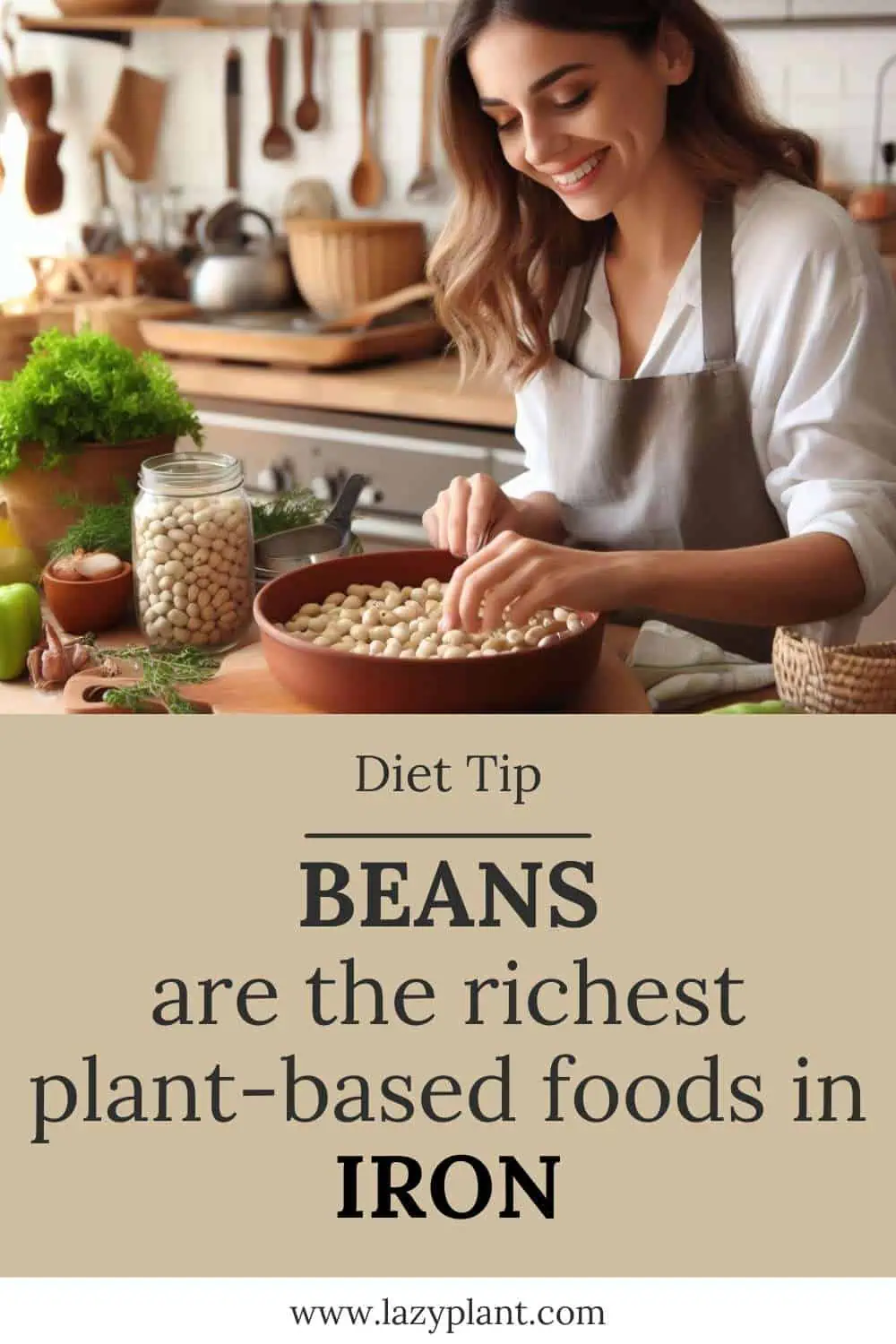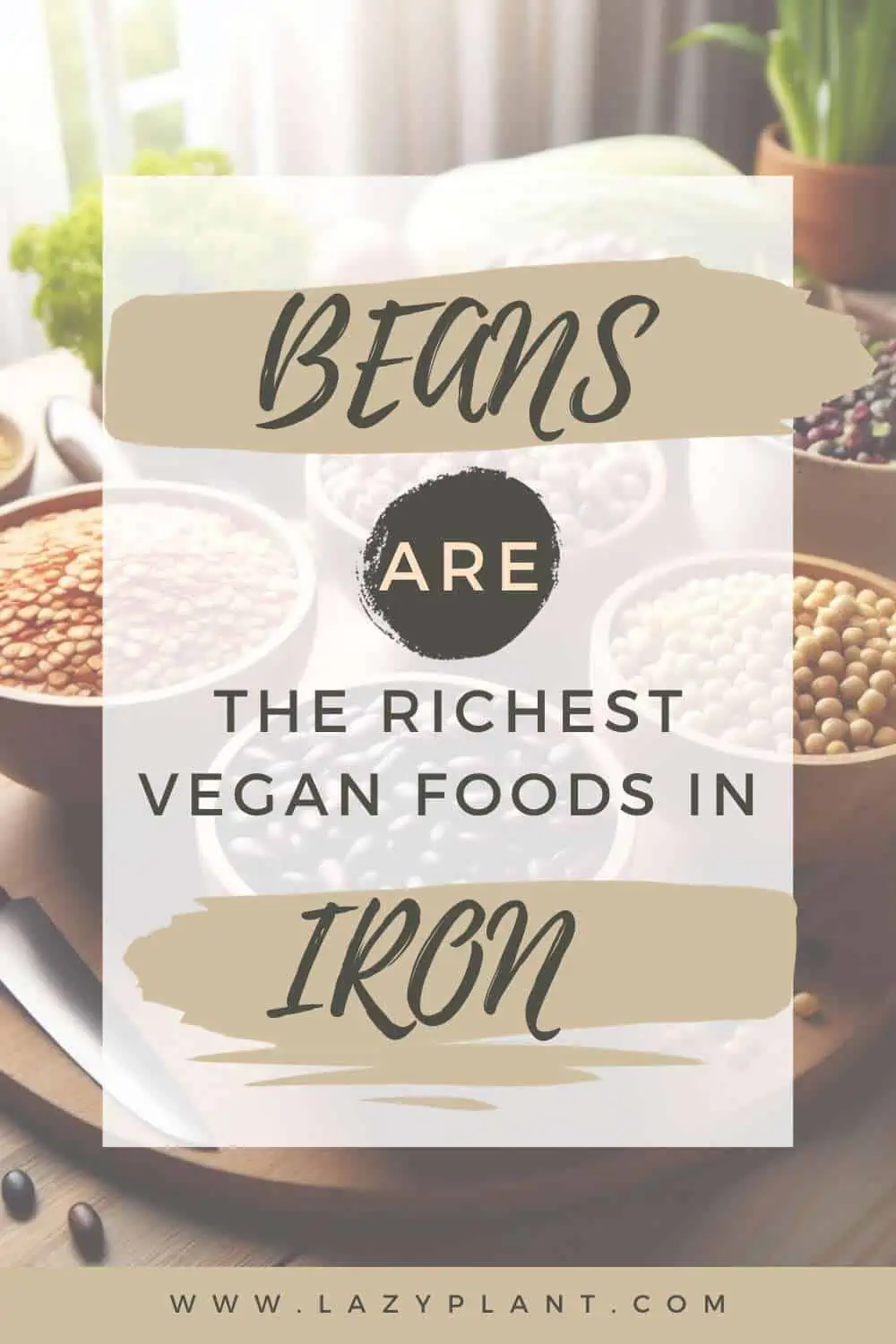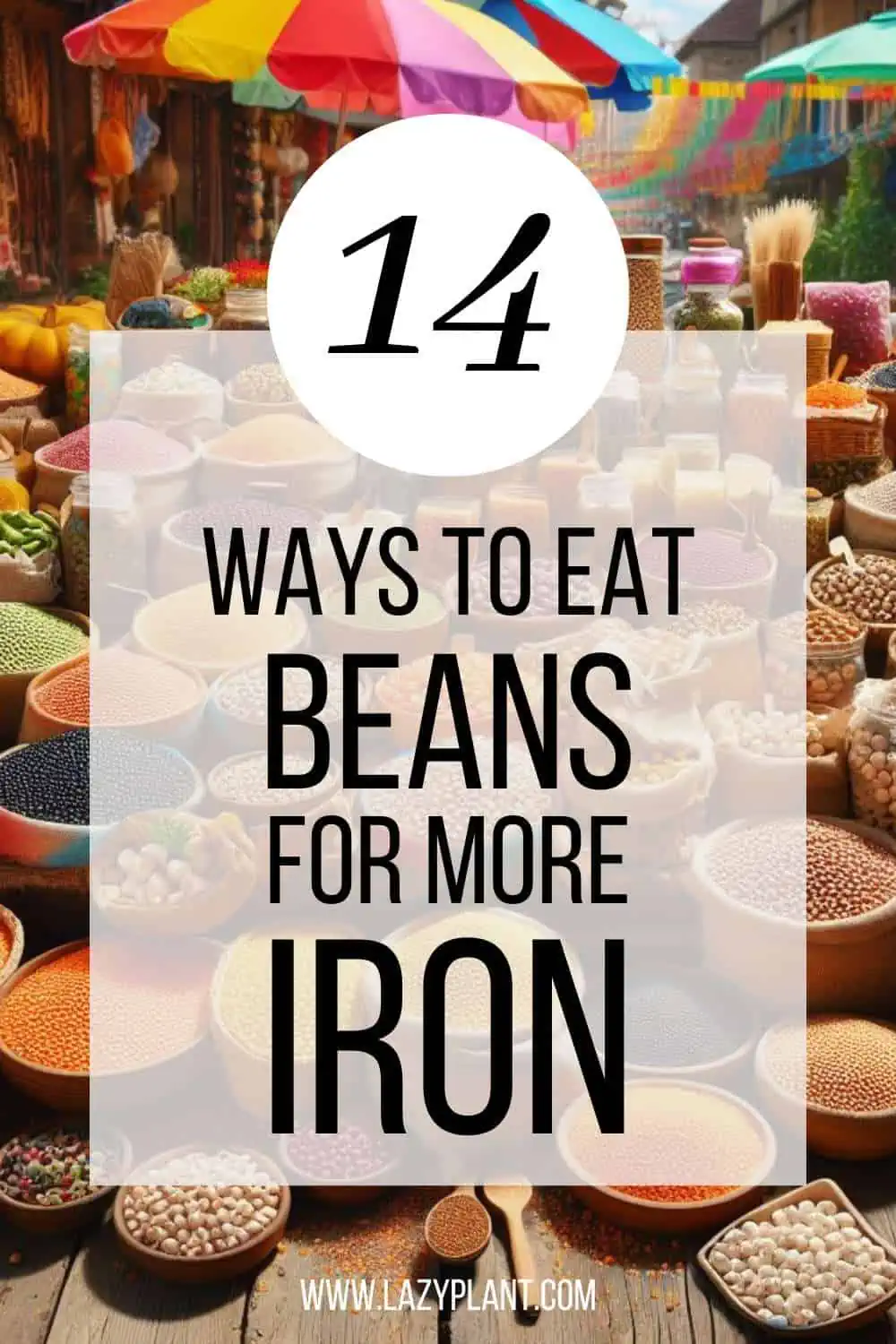Beans are the richest plant-based foods in iron. A serving can provide almost 50% of the required daily intake of iron! But, as we absorb only a small percentage, we should eat beans with certain foods that increase their iron bioavailability.
Health benefits of iron
Iron is necessary for good health. It’s a key component of hemoglobin; a protein of red blood cells that transfers oxygen from the lungs to the tissues.
Additionally, iron supports muscle metabolism and healthy connective tissue. Also, it’s crucial for energy metabolism, cellular functioning, physical growth, neurological development, and the synthesis of some hormones, amino acids, and collagen.[1,2]
But, iron deficiency is the most common nutritional deficiency worldwide! It may lead to serious side effects, such as gastrointestinal disturbances, impaired cognition, weakened immune function, fatigue, and low body temperature. Moreover, iron deficiency during pregnancy increases the risk of premature delivery, and miscarriage.[3]
How much iron do we need a day?
The recommended daily intake of iron is 18 mg for women and 8 mg for men. Women require much higher doses due to the menstruation period.
Pregnant women require much higher dosages of 27 mg a day.
In contrast, women older than 51 years require only 8 mg of iron a day.
It may be tricky for women of reproductive age to get the recommended iron intake from their diet. They may benefit from taking a dietary supplement.
You’ll find a wide variety of iron supplements on iHerb.
What’s the iron content of beans?
Actually, beans are particularly high in iron. They can help us meet our daily needs.

Soybeans are the richest beans in iron. A serving of soybeans provides almost half of the required daily iron intake!
White beans and lentils are also particularly high in iron. A serving provides almost 40% of the required daily dose.
| iron (mg) per 100g | iron (mg) per serving | % DV | |
| soybeans | 5.1 | 8.8 | 49% |
| white beans | 3.7 | 6.7 | 38% |
| lentils | 3.3 | 6.6 | 37% |
| kidney beans | 2.9 | 5.2 | 29% |
| chickpeas | 2.9 | 4.7 | 26% |
| lima beans | 2.4 | 4.5 | 25% |
| navy beans | 2.4 | 4.3 | 24% |
| tofu | 4.9 | 4.1 | 23% |
| pink beans | 2.3 | 3.9 | 22% |
| pinto beans | 2.1 | 3.6 | 20% |
| fava beans | 1.5 | 2.6 | 14% |
Most beans are great dietary sources of iron. They contain more than 20% DV (Daily Value) of iron per serving. Only fava beans are relatively low in iron.
In fact, fava beans have the least iron as compared to other beans. A typical serving of cooked fava beans provides only 14% DV.
Do we absorb iron of beans?
We absorb only a small percentage of iron from beans, as well as other plant-based foods. It’s estimated that the bioavailability of nonheme iron (iron in plants) is between 5% and 12%.
However, the iron absorption in certain bean varieties can be as low as 2%. Especially if they’re combined with foods that inhibit iron absorption.
In contrast, the bioavailability of iron from mixed diets containing both animal-based and plant-based foods is 14-18%.
We absorb only a small percentage of iron in beans because they’re high in phytic acid and polyphenols. These compounds bind to iron, inhibiting its absorption. Whole grains are rich in these compounds as well.[5]
Rinse your beans for better iron absorption
Soak and rinse the beans thoroughly. A high percentage of these compounds will leach into the water. The removal of phytic acid and polyphenols can increase iron absorption up to 2.6-fold.[6]
Also, soaking beans before cooking can help improve their digestibility.
Soak them for at least 4–8 hours or overnight. Here’s a simple guide to soaking beans:
- Rinse: Rinse the beans thoroughly under cold water to remove any dirt or debris.
- Soak: Place the beans in a large bowl and cover them with enough water to submerge them completely. Allow them to soak for at least 4–8 hours or overnight.
- Drain and Rinse: After soaking, drain the beans and rinse them again under cold water.
- Cook: Transfer the soaked beans to a pot, cover them with fresh water, and cook according to your recipe.
You could add some baking soda to the soaking water or during the cooking process to help soften the beans and reduce cooking time! A common recommendation is to use about 1/4 teaspoon of baking soda per pound of beans during soaking.
You should be mindful of the quantity, as excessive amounts may affect the flavor and texture of the beans. Also, too much baking soda can be dangerous for certain people. Small doses may have beneficial effects, though.
Iron in white beans is more bioavailable!
Moreover, the iron bioavailability of beans depends on the variety. For instance, we absorb more iron from white beans than from red beans. Red beans have a much higher polyphenol content.[7]

As a rule of thumb, colorful plants contain more polyphenols! You shouldn’t avoid them, though. Although polyphenols inhibit iron and other mineral absorption, they are powerful antioxidants! Antioxidants help prevent chronic inflammatory diseases and oxidative stress.
Eat meat & foods rich in vitamin C with beans
Also, vitamin C, meat, poultry, and seafood can enhance nonheme iron absorption. Therefore, you could increase the absorption of iron in beans by combining them with meat or foods high in vitamin C like peppers, tomato, broccoli, cauliflower, lemon juice, or kale.
Avoid eating beans with dairy products
On the other hand, high amounts of calcium might reduce the bioavailability of both nonheme (present in plants) and heme (present in meat) iron.
Other inhibitors of iron absorption are coffee and tea, due to their high polyphenol content. Avoid drinking these beverages close to a bean dish.
Can I depend on beans for iron?
While beans can contribute to your overall iron intake, it’s essential to have a well-rounded diet that includes a variety of iron-rich foods.
If you have specific concerns about iron deficiency or absorption, it’s advisable to consult with a healthcare professional or a registered dietitian, who can provide personalized advice based on your individual health needs.
Are beans the main source of iron for vegans & vegetarians?
It’s essential for vegans and vegetarians to diversify their iron sources and adopt strategies to enhance iron absorption.
People who follow a plant-based diet should include a variety of iron-rich plant foods in their diet, such as lentils, chickpeas, tofu, tempeh, fortified cereals, nuts, seeds, and dark leafy greens.
Fortified foods, such as iron-fortified cereals or plant-based milk alternatives, can also play a significant role in meeting our daily needs of iron.
Bean recipe ideas for better iron absorption
Incorporating ingredients high in vitamin C, such as citrus fruits, tomatoes, or bell peppers, into bean recipes enhances the absorption of non-heme iron from beans.
Additionally, using cast iron cookware can also contribute to the iron content of your meals.
Here are 14 recipes featuring beans and other iron-rich ingredients to enhance iron absorption:
- Chicken and black bean tacos: Cook shredded chicken with black beans, onions, and bell peppers. Serve in taco shells with a salsa made from tomatoes, cilantro, and lime juice.
- Lemon-garlic salmon with lentils: Pan-sear salmon with a lemon-garlic marinade and serve over a bed of cooked lentils, sautéed spinach, and cherry tomatoes.
- Beef and lentil stew: Make a hearty stew by combining beef, lentils, carrots, celery, and tomatoes. Add a splash of lemon juice for brightness.
- Turkey and white bean chili: Cook ground turkey with white beans, tomatoes, chili spices, and onions. Serve with a side of sliced oranges or a citrus salsa.

- Pork and pinto bean burritos: Sauté pork with pinto beans, onions, and spices. Fill burritos with the mixture and top with a salsa made from tomatoes, peppers, and lime.
- Chicken and chickpea curry: Make a flavorful chicken and chickpea curry with tomatoes, coconut milk, and a blend of Indian spices. Serve over basmati rice.
- Lime-marinated steak with adzuki bean salsa: Marinate steak in a lime-based marinade, grill, and serve with a salsa made from adzuki beans, corn, tomatoes, and cilantro.
Vegan recipe ideas
- Lentil and spinach soup: Combine lentils, spinach, tomatoes, and vegetable broth. Add a squeeze of lemon juice before serving for vitamin C.
- Chickpea and quinoa salad: Mix cooked chickpeas, quinoa, cherry tomatoes, cucumber, and bell peppers. Drizzle with a dressing made from olive oil, lemon juice, and herbs.
- Black bean and bell pepper stir-fry: Stir-fry black beans with colorful bell peppers, onions, and garlic. Serve over brown rice for a hearty meal.
- Hummus and veggie wrap: Spread homemade hummus on a whole-grain wrap and fill it with a variety of colorful vegetables like spinach, tomatoes, and bell peppers.
- Spinach and white bean salad: Toss white beans with fresh spinach, cherry tomatoes, red onions, and a lemon vinaigrette.
- Vegan three-bean chili: Create a hearty chili with kidney beans, black beans, pinto beans, tomatoes, and chili spices. Top with avocado for added creaminess.
- Tofu and chickpea stir-fry: Stir-fry tofu and chickpeas with broccoli, snap peas, and carrots. Serve over quinoa or brown rice.
Other foods high in iron
Common foods high in iron are meat, poultry, fish, eggs, whole grains, legumes, as well as certain fruits and vegetables.
Spinach has a good iron content as well. A serving provides 17% of the recommended daily intake! Potatoes, dark chocolate, and tahini are also favorite foods high in iron!
Drinking certain fruit juices could help meet our daily iron needs as well.
Why should we eat beans regularly?
Beans are among the healthiest foods you can eat. Besides iron, they’re packed with minerals like potassium, magnesium, calcium, and zinc.
Most noteworthy, due to their antioxidant compounds, long-term consumption of beans may lower LDL-cholesterol and systolic blood pressure. Regular consumption of beans may reduce the risk of heart disease and diabetes as well.[8]
Also, beans may reduce the risk of certain cancers, like colon cancer![9]
As beans are low in sugars, even people with diabetes can consume reasonable amounts. Beans contain nutrients that help control blood sugar levels.